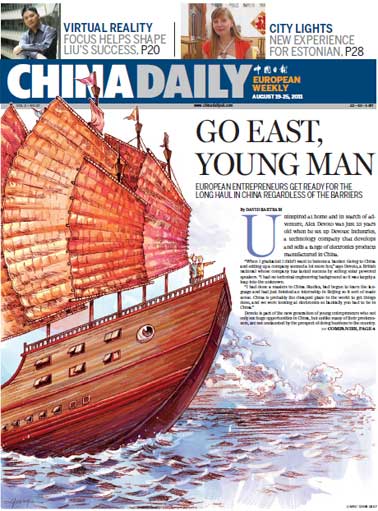Value chain should drive profit model
Updated: 2011-09-23 08:37
By Jiang Desong (China Daily)

There are still many lessons to learn 10 years after China joined the World trade organization
Chinese companies are not active in going out and harnessing global resources 10 years after the country joined the World Trade Organization. So how can they obtain and use such resources?
Over the past 10 years the Chinese economy has been the most stable and the fastest growing. At the end of last year China replaced Japan as the world's second-largest economy, justifying its entry into the WTO. Doubts over the WTO's potential damage to China's domestic market have evaporated, and Chinese companies are eager to reshape competition in the world market.
But have they mastered the skills to be competitive?
The world order has changed greatly since China entered the WTO. The new international trade system, the export-led model to economic growth and WTO rules have pushed China into the downstream of the economic value chain.
It has become apparent over the past 10 years that there are essentially five ways in which Chinese companies are harnessing or trying to harness international resources. Analyzing these methods will help us decipher global trends and to draw a picture of the competition system and the industry value chain.
1. Demand and supply
The massive expansion of Chinese-made products has triggered the country's demand for raw materials, especially in bulk commodities including petroleum, natural gas, coal, and iron ore. Since 2003 Chinese enterprises have tried to break the bottleneck of resource shortages through overseas mergers and acquisitions.
However, acquisitions by Chinese State-owned companies overseas have been controversial. Countries, particularly developed ones, have been wary of such acquisitions, so the success rate has been low. Scarce energy resources have also contributed to this resistance.
China is eager to buy resources from upstream industries to stabilize domestic supply, but once the economy slows and overseas demand drops, inventory in the end-use market will increase, as will capital depreciation in upstream industries.
2. The value chain
For a long time Chinese companies have failed to invest enough in branding, sales venues, and studying consumer behavior. When the cost of "made in China" rises, companies need to shift their attention to brand, technology and upstream resource management.
China Dongxiong Sports is an example. It analyzed consumer behavior in China's sportswear market, and bought Kappa in the mainland from Italy's BasicNet. Its focus on brand management has resulted in Kappa's excellent performance. The design and marketing strategies work very well in the market place.
3. Global business expansion
Expanding overseas is the ultimate goal of many Chinese businesses. Setting up transnational enterprises is not just a question of business, but can bring into play political rivalry and issues of cross-cultural integration.
The state of China's foreign currency reserves has raised many management challenges. The Chinese government set up sovereign investment funds like China Investment Corporation to focus on overseas investment. And some State-controlled commercial banks, such as the Industrial and Commercial Bank of China, have begun making acquisitions and setting up branches overseas. Previously, China Merchants Bank had bought Wing Lung bank of Hong Kong.
Overseas financial management is at the center of this way of using resources.
4. Takeovers and acquisitions
Over the past 10 years Chinese enterprises have made great strides in acquiring traditional manufacturing industries overseas. Indeed, the scope has widened to high-end manufacturing. China can now take charge of such transfers as domestic demand for such industry is still high.
5. Copy innovation
China can match the rest of the world in the Internet not because of technological innovation, but because of business mode replication. This kind of integration has given rise to Internet talents such as Robin Li of Baidu and Charles Zhang of Sohu.
They have all borrowed on the business model from that of developed countries' high-tech industries. Their key word is service, they keep their eye on market changes and they localize the business model they are copying.
They have also made use of private funds and international capital markets. By doing so they multiply their market value to realize their competitive edge.
In January the WTO Director-General, Pascal Lamy, said that China's entry to the organization had been a winning proposition for all members. Furthermore, he said that the WTO would not be a world trade organization without China.
Such comments can be applied to the past 10 years, but of course new problems have been thrown up. When China dives head first into the globalization tide as the world's second largest economy, what will become of the global economy?
Japan once wanted to replace the US order but found itself knocked back by globalization and its cultural insularity. Now China has shown its strength in global competition, but a Chinese version of globalization is impractical.
Harnessing global resources will remain the theme for many years. Harnessing resources does not necessarily mean capturing them, or acquisition being the only one way ahead.
Modern business organizations are born to create profits, and various business models are derived from various profit growth models. Harnessing resources comes down to this: improving a company's profit growth and ensuring that the company stays competitive.
The traditional profit model relies on mass production, professional division and technological innovation. All these can keep commodity prices to the minimum. However, goods are now abundant, and price is not the sharp-edged tool to attract consumers that it once was. Companies need more than low prices to make competitive and sustainable long-term profits and to increase the company's value.
Apple's success over the past 10 years has demonstrated a new business trend. Apple has established a new trans-industry business chain with different industry values by setting up a business connection between its iPod, iPhone, iTunes products and its service.
In this new industry value chain, consumers can define their own consumption, meaning we have a real consumer-led business model. Apple avoided direct competition with its adversaries. In contrast, its mobile phone rivals still focus on market share, spending huge amounts on marketing. Competition is fierce, but the outcome leaves something to be desired.
Rather than focusing on competition in the industry value chain, global commerce now focuses on integration in that chain. Louis Gerstner, the CEO who led the successful transformation at IBM, was fully aware of that. With his strategic reforms at "Big Blue" he avoided chasing after extreme technology innovation, and at the same time made sure he did not provoke his rivals. One important factor in his success was helping clients deepen their knowledge of information technology, and helping them know how to make use of it to improve company value.
The author is assistant director of innovation research center at Cheung Kong Graduate School of Business. The opinions expressed in the article do not necessarily reflect those of China Daily.
E-paper

The snuff of dreams
Chinese collectors have discovered the value of beautiful bottles
Perils in relying on building boom
Fast forward to digital age
Bonds that tie China. UK
Specials

Let them eat cake
Cambridge University graduate develops thriving business selling cupcakes

A case is laid to rest
In 1937, a young woman'S body was found in beijing. paul french went searching for her killer

Banking on change
Leading economist says china must transform its growth model soon
